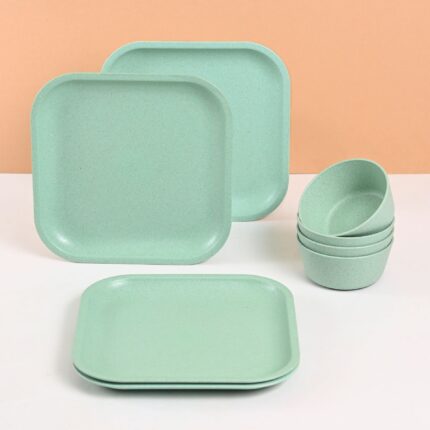Eco-Friendly Tableware: Top Picks for Guilt-Free Dining

Eco-Friendly Tableware: Top Picks for Guilt-Free Dining
Ever caught yourself staring at your dinner plate or bowl, wondering if it’s secretly plotting against the planet? Yeah, me too. It’s like, here I am, trying to save the world one reusable grocery bag at a time, and my dinnerware’s giving me the side-eye.
So, what’s an eco-conscious foodie to do? Eat straight off the cooking pan?
Nah, turns out there’s a better way. Welcome to the wild world of eco-friendly tableware. Spoiler alert: it’s not all bamboo and bagasse.
First up: the big questions. You know, the ones that keep you up at night, scrolling through endless product reviews:
1. Is this stuff actually gonna last? Or will it disintegrate faster than my New Year’s resolutions?
2. Can I put it in the dishwasher, or am I signing up for a lifetime of hand-washing purgatory?
3. Will it make my food taste like I’m licking a tree? (Looking at you, weird bamboo, pulp aftertaste.)
Let’s break it down, shall we?
The Good, The Bad, and The Eco-Friendly Tableware
1. Stainless Steel: The Superhero of Sustainable Dinnerware
Pros: Basically indestructible. No taste issues. Dishwasher safe. Can be recycled after use.
Cons: Bit heavy. Might make you feel like you’re camping. Not microwave safe.
Best for: Lifetime use, people who break everything (you know who you are).
Caution: You just need to watch your pocket as they are usually costlier option.
2. Glass: Crystal clear and here to stay
Pros: Dishwasher and Microwave safe. Can be recycled after use.
Cons: Heavy and most delicate of the lot. Easily breaks and shatters.
Best for: Use at home, people who are gentle with stuff.
Caution: Handle with care. At the time of disposal, hand it over for recycling.
3. Ceramics: The not-so earthen choice
Pros: Easy to use, Dishwasher and Microwave safe.
Cons: Heaviest of the options. Easily breaks and chips. Cannot be recycled or biodegradable.
Best for: Use at home, people who are very careful in handling stuff(you know who you are).
Caution: Avoid the cheap stuff available.
4. Bamboo: The OG of Eco-Friendly Dinnerware
Pros: Grows faster than my kid’s shoe size – that’s about bamboo only.
Cons: Most bamboo tableware are mixed or coated with toxic chemicals such as formaldehyde or boric acid – that’s carcinogenic. Can’t handle hot stuff. If not treated properly, they leave a weird taste.
Best for: Cold snacks, picnics.
Caution: Check the fine lines about the product before you purchase. Consider our bamboo fiber biocomposites based products that are safe and sustainable.
5. Wheat Straw: Not Just for Scarecrows Anymore
Pros: Dishwasher safe. Microwave safe. Better than plastic.
Cons: Mostly made in China, so you never know what you get.
Best for: Everyday use, clumsy people (guilty), hot meals.
Caution: Check where the products are made before you purchase. Explore our rice husk biocomposites based products instead of wheatstraw.
6. Recycled Plastic: When You Can’t Quit Plastic Cold Turkey
Pros: Durable. Dishwasher safe. Microwave safe. Familiar feel.
Cons: Hard to distinguish good and the bad ones.
Best for: Outdoor use, kids who treat plates like frisbees.
Caution: Look for only certified products with proper traceability of materials.
7. Palm Leaf: Fancy Pants Eco-Warrior
Pros: Looks Instagram-worthy. Biodegradable.
Cons: Single-use. Bit pricey for something you’re gonna compost.
Best for: Fancy parties, impressing that one judgy vegan friend.
Caution: Watch out for any fungal development. Thoroughly wash before use. Always dispose them in a composting bin.
8. Bagasse: Not as sustainable as they claim to be
Pros: Biodegradable.
Cons: Single-use. Can get soggy with Indian food. Bit pricey for something you’re gonna use only once.
Best for: Parties, picnics and grabbing a bite at your favorite fast-food joint.
Caution: Wipe it with cloth before use. Always dispose them in a composting bin.
Real Talk: Making the Switch to Eco-Friendly Dinnerware
Look, I get it. Overhauling your entire dining table overnight is about as realistic as me suddenly loving kale. But small changes add up. Here’s how to dip your toe in the eco-friendly waters:
1. Start with your most-used item. It could be coffee mug, plates or bowls. (No, wine glass doesn’t count as tableware. I checked.)
2. Replace things as they wear out. Lets avoid unnecessary waste of useful stuff.
3. Mix and match. Who says your table settings have to match?
4. Gift it. Next time someone asks what you want for your birthday, hit ’em with the eco-friendly wish list.
5. Do your homework. Not all “eco-friendly” is created equal. Do your research, or ya know, just keep reading our blog. We’ve got you covered.
The Bottom Line
At the end of the day, the most sustainable tableware is the stuff you already own. Use it till it breaks, then make the switch. And when you do, come chat with us. We’ve got options that’ll make both your dinner table and Mother Nature happy.
Looking for Eco-Friendly Dinnerware?
Visit eha’s range of earth friendly tableware products to choose from products made with biocomposite materials using crop-waste such as rice husk, bamboo fibers and coffee husk.
If you are looking at developing new range of eco-friendly tableware and eco-friendly dinnerware products, speak to experts at Mynusco.



































